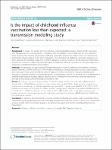Is the impact of childhood influenza vaccination less than expected: a transmission modelling study
Weidemann, Felix
Remschmidt, Cornelius
Buda, Silke
Buchholz, Udo
Ultsch, Bernhard
Wichmann, Ole
Background: To reduce the burden of severe influenza, most industrialized countries target specific risk-groups with influenza vaccines, e.g. the elderly or individuals with comorbidities. Since children are the main spreaders, some countries have recently implemented childhood vaccination programs to reduce overall virus transmission and thereby influenza disease in the whole population. The introduction of childhood vaccination programs was often supported by modelling studies that predicted substantial incidence reductions. We developed a mathematical transmission model to examine the potential impact of childhood influenza vaccination in Germany, while also challenging established modelling assumptions. Methods: We developed an age-stratified SEIR-type transmission model to reproduce the epidemic influenza seasons between 2003/04 and 2013/14. The model was built upon German population counts, contact patterns, and vaccination history and was fitted to seasonal data on influenza-attributable medically attended acute respiratory infections (I-MAARI) and strain distribution using Bayesian methods. As novelties we (i) implemented a stratified model structure enabling seasonal variability and (ii) deviated from the commonly assumed mass-action-principle by employing a phenomenological transmission rate. Results: According to the model, by vaccinating primarily the elderly over ten seasons 4 million (95% prediction interval: 3.84 – 4.19) I-MAARI were prevented which corresponds to an 8.6% (8.3% – 8.9%) reduction compared to a no-vaccination scenario and a number-needed-to-vaccinate (NNV) to prevent one I-MAARI of 37.1 (35.5 – 38.7). Additional vaccination of 2-10 year-old children at 40% coverage would have led to an overall I-MAARI reduction of 17.8% (17.1 – 18.7%) mostly due to indirect effects with a NNV of 20.7 (19.6 – 21.6). When employing the traditional mass-action-principle, the model predicted a more than 3-fold higher I-MAARI reduction (55.6%) due to childhood vaccination. Conclusion: In Germany, the introduction of routine childhood influenza vaccination could considerably reduce I-MAARI among all age-groups and improve the NNV. However, the predicted impact is much lower compared to previous studies, which is primarily caused by our phenomenological approach to modelling influenza virus transmission.
Dateien zu dieser Publikation
Keine Lizenzangabe

